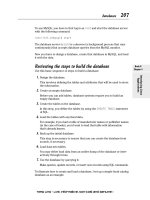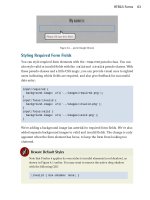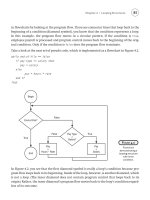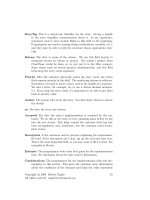Extreme Programming in Perl Robert Nagler phần 4 docx
Bạn đang xem bản rút gọn của tài liệu. Xem và tải ngay bản đầy đủ của tài liệu tại đây (176.28 KB, 16 trang )
6.7 Yea, Whatever
Not everybody in my company can sustain pair programming all
the time. We try to flex to each other’s styles when we can.
Sometimes it just doesn’t work.
One of my partners gets what I call the “yea whatevers” when
he’s had enough pair programming. He ends up saying, “yea,
whatever” whenever there’s some type of disagreement. The yea
whatevers only happen after too many conflicts in one session.
Our personalities would start hindering our efforts if we continued
pair programming so we know it’s time to stop.
XP promotes people over process first, and a set of best practices,
second. If the people dynamics aren’t right, I don’t recommend
forcing pair programming. It’s taken this programmer and me
years to figure out what works best for us. We didn’t start out
pair programming when we first started working together, and we
don’t pair continuously all the time now. Most of the time, we
pair when we run into a roadblock, and we know we need help.
This also turns out to be a good way to introduce pairing, that is,
waiting until you get a hard problem before you bring in a partner.
It may be something you do already, possibly at a whiteboard.
Next time, try sharing a keyboard instead. You will be surprised
how much more effective it is to communicate through the code
than in a conference room.
A whiteboard solution is theoretical, and code is being there. It’s
like the difference be tween planning to climb a mountain and hoot-
ing in unison when you both reach the top. Coding together
means helping each other with the inevitable wrong turns and
near falls. You gain mutual respect and learn to trust each other.
You can’t pair program effectively without these qualities, and
the best way to get there is by working side by side on a hard
problem.
6.8 Gumption Traps
Bad hair days are when nothing seems to go right. Robert Pirsig says this
happens when you run into a gumption trap, something that saps your
energy, discourages you, and causes you to make mistakes. Some examples
Copyright
c
2004 Robert Nagler
All rights reserved
44
of gumption traps are:
9
Intermittent Failure In this the thing that is wrong be com es right all of
a sudden just as you start to fix it.
Parts Setback It’s always a major gumption trap to get all the way home
and discover that a new part won’t work.
Value Rigidity The facts are there but you don’t see them.
Ego Traps When the facts show that you’ve just goofed, you’re not as
likely to admit it. When false information makes you look good, you’re
likely to believe it.
Pirsig defines these gumption traps in terms of motorcyc le maintenance,
but they apply equally well to software development. Whether you are a
mechanic or programmer, gumption traps keep you from getting your job
done.
You can get out of gumption traps by yourself. Pirsig gives solutions for
each of these traps. The biggest problem is recognizing that you have fallen
into one. Even when you recognize you are in a trap, it can take you days
to get out of one, if you are working alone. With a partner you’ll probably
be out in a few hours or possibly even minutes.
You and your partner think differently. You have different backgrounds
and skills. When you are pair programming together, these differences bal-
ance each other out to help both of you avoid and recover from gumption
traps.
Each of you probably won’t fall into the same gumption traps. If you
both fall into the same trap, one of you will come out first and help the
other out. I’m sure you have had the experience of searching for a code
defect with another person. It would be a rare event for both of you to find
it at the exact same moment. It doesn’t matter who finds it first, because
both of you can continue coding once it is found.
6.9 Reducing Risk Through Knowledge Transfer
Programming pairs are not only better at finding defects, they produce bet-
ter code and learn more than solitary programmers. Programming partners
often come up with two different implementations for the same task. One
9
Zen and the Art of Motorcycle Maintenance, Robert M. Pirsig, Bantam Books, 1989,
p. 277-283.
Copyright
c
2004 Robert Nagler
All rights reserved
45
or both of the implementations might contain ideas new to the other per-
son. You’ll discuss the differences, and possibly merge the solutions. In any
event, one or both of you have learned something.
One partner is likely to know more about the code or problem you both
are working on than the other. While you add business value to the project,
the more experienced partner transfers knowledge to the less experienced
partner. When all production code is written in pairs, no one person has
unique knowledge of the codebase. This reduces risk, and spreads experi-
ence. Everybody benefits from the continous learning that goes on in an XP
project. In addition, the customer benefits from the reduced risk and from
the increased quality that pair programming delivers.
Copyright
c
2004 Robert Nagler
All rights reserved
46
Chapter 7
Tracking
He achieves successes
he accomplishes his tasks
and the hundred clans all say: We are just being natural.
– Lao-Tze
1
XP’s focus is on the here and now. The team knows how it is doing
by eliciting feedback through testing and frequent releases. Sometimes this
feedback is not enough to keep a project on track. Everybody strays from
the path now and then, and runs the risk of getting caught in a web made
by a big, hairy spider. That’s why every XP project needs a tracker.
Tracking in XP let’s us know if we’ve strayed off the path. Tracking
introduces feedback about how we are doing with respect to iteration and
release plans. The tracker is the team member who is responsible for asking
the team how far along they are with their tasks for the iteration. If the
iteration is be hind schedule, the tracker asks the customer to drop tasks.
Intra-release feedback is generated by tracking the velocity trend. When
the velocity curve is unstable, it’s a sign of trouble.
The role of tracker is typicially filled by a manager, but can be anybody
who communicates well with the rest of the team. The tracker’s job is to
help find root causes as well as gather data about the project’s status. To be
effective, the tracker must be a perceptive listener to hear the subtle clues
that lead to root causes.
1
The Tao of The Tao Te Ching, Lao-Tze, translated by Michael LaFargue, SUNY
Press, 1992, p. 118.
47
This chapter explains how tracking works, what’s tracked, ways to keep
everybody informed, and most importantly, how to get back on track if
you’re lost battling big, hairy spiders.
7.1 Iteration Tracking
Iteration tracking is a polling activity. The tracker asks team memb ers how
their work is going once or twice a week. These meetings are between the
tracker and one team member at a time. This keeps everyone at ease, and
allows the tracker to ask personal questions if need be.
To simplify tracking, try to limit task length to one ideal day. With
multi-day tasks, the tracker needs to ask how much time is left to get a
precise reading of the project’s status. With single day tasks, the tracker
need only ask whether the task is completed or not. This latter precision is
enough to provide an accurate picture of the iteration’s progress.
Iteration tracking is not micro-management. The tracker doesn’t try to
control how people do things. The purpose of tracking is to find out what is
happening using a simple, objective measure, such as, what tasks are done
and what are their estimates . If the tracker has to ask how close a task is
to being done, the m eas ure is less objective, and the tracker may have to be
more intrusive into how the team member came up with the estimate. The
simple binary test (“is it done?”) avoids this extra level of detail, and keeps
the meetings shorter and more straightforward.
After the tracking meetings, the tracker sums the estimates of completed
tasks, divides the sum by the current velocity, and multiplies by 100. The
result is the percentage of planned work which has been completed for this
iteration. If the number is 60% and you are at the end of day three of a one
week iteration, the iteration is on track. If the number is lower, the tracker
needs to ask the customer to cut scope.
7.2 Don’t Slip the Date
Traditional project management tends towards adjusting the schedule to
meet reality, that is, scope is fixed, and it’s the date that needs to slip. XP’s
view is that scope is variable, and it’s more important to keep dates fixed.
If you change the date, the entire team has to be involved. The team
members who are on track will need new tasks (more communication). Their
flow will be disrupted by an extra meeting to figure out what tasks need to
be added.
Copyright
c
2004 Robert Nagler
All rights reserved
48
The cheape r alternative to slipping the date is to cut tasks. This is
less costly in terms of communication. The tracker already knows which
tasks are in trouble, and he is already are talking with the people who are
responsible for them. The tracker’s job is to make the customer aware of
the problems. The programmers who are on track needn’t be bothered.
The customer picks which stories to drop. The tracker gives the customer
the raw data (list of problematic stories) as well as your own interpretation
of the factors involved. Call in the programmers to help you explain the
details if need be. The better informed the customer is, the more easily she
can decide what to drop.
7.3 Adding Tasks
Believe it or not, there are times when stories need to be added to an itera-
tion. For example, the customer may see an important problem while using
the prior iteration or a programmer may have finished all his tasks before
the end of the iteration.
The customer decides what to add. The tracker only involves those
programmers who are available for the additional stories. Not that the
cusomter must stay within budget, so tasks may need to be dropped to
balance out the additions. The tracker gives the customer a list of tasks in
progress to help prevent unnecessary task switching.
7.4 The Tracker
The tracker must be someone who can speak directly to all team members.
He needs to be a perceptive listener, because tracking is more than just
numbers. It’s about finding root causes and resolving them. Most problems
you run into are related to the people, not the technology. And, people are
needed to solve them.
The role of tracker is best played by the project manager, in my opinion.
Alternatively, you may want to rotate the position of Tracker throughout
your project, or rotate the trackers between projects. Tracking, like man-
agement in general, needs to be understood by the whole team.
2
Rotating
everybody through the position of tracker, gives the entire team the op-
porunity to see the forest for the trees.
2
If you want to know why management is important, pick up a copy of What Man-
agement Is: How it works and why it’s everyone’s business, Joan Magretta, Simon and
Schuster, Inc., 2002. It’s an excellent, slim book on management.
Copyright
c
2004 Robert Nagler
All rights reserved
49
7.5 Release Tracking
The simplest way to track release progress is with a graph of velocity. The
graph should quickly converge on a constant value, for example:
Typical Velocity Graph
Velocity converges when the task estimates align with actual capacity.
Once this happens, velocity should remain relatively constant.
Now let’s take a look at a graph from a troubled project:
3
Troubled Project’s Velocity Graph
3
This data was taken from 10 week-long iterations from a project at my company.
Copyright
c
2004 Robert Nagler
All rights reserved
50
The project started out normally with velocity starting to converge
around the third and fourth iteration. By the fifth or sixth iteration ve-
locity started to drop off. The projec t was in serious trouble by the ninth
iteration. The next step is figuring out why.
7.6 What Goes Wrong?
Finding the root cause for a velocity trend change c an be difficult. In this
project, we had a problem with quality which was indicated by an increase
in the number of stories to fix defects. This was obvious when reviewing
the story cards. When I went back to review the cards for this chapter, it
struck me that the task estimates seem shorter as the project progressed.
While I don’t recommend tracking average task length in general, the graph
illuminates the problem in this case:
Troubled Project’s Average Task Length Graph
Copyright
c
2004 Robert Nagler
All rights reserved
51
The graph shows that the average task length started dropping around
the fourth iteration. In conjunction with the drop in velocity, this indicates
the tasks were shorter, and we were underestimating them. These symptoms
are indicative that change was harder, and were probably caused by quality
issues. The team was battling the big, hairy, low quality spider.
Low quality is not a root cause, rather it’s a symptom of not using best
practices. After reviewing the project, we attributed the poor quality to the
following root causes:
Customer Unavailable The customer didn’t s tart using the system until
the fifth iteration.
Too Few Acceptance Tests The team didn’t test end to end function.
It was thought there wasn’t enough time, and was partially related to
the team’s relative inexperience.
Inexperience The domain, development environment, Perl, and XP were
all new to the developers. The customer was new to XP. Doing too
many new things at once is rarely a good idea, and in this c ase, was a
significant weak point.
In the next section, you’ll see how we fixed these problems. For now, let’s
take a look at a few other problems you might encounter when developing
with XP:
Copyright
c
2004 Robert Nagler
All rights reserved
52
Failing to Finish The customer does not stop making changes, and won’t
launch until all changes are done. This is a planning failure. With
XP, you need to pick dates, and stick to them. The tracker should
noticed that dates are slipping. In XP, we don’t slip dates, we cut
scope instead.
Too Little Refactoring Refactoring is put off until after launch. This re-
duces quality, which can be difficult to recover from, because the team
falls into the bug-fixing trap soon after launch. Too little refactor-
ing multiplies defects through copy-and-paste-itis: an inflammation of
defects c aused by over use of the copy-and-paste function in e ditors.
The tracker should notice that the code base is growing too rapidly.
If the number of lines of code is growing linearly with the number of
ideal days, it means there’s not enough refactoring. It’s unlikely that
every programmer thinks up the right code abstraction for every task.
The programmers have to refactor to create the right abstractions, and
that will shrink the code base.
Too Much Refactoring The programmers are perfectionists, and they
won’t stop trying to improve the code. This greatly reduces the
amount of business value being added, and pushes off the launch date.
This one may be a bit tricky to notice with a simple velocity graph,
because the velocity may be constant. This is where the tracker needs
to use his sixth sense that velocity is simply too low.
Not Enough Unit Tests Finding the right balance on unit tests is not
easy, but it’s fairly clear when there aren’t enough: the team is afraid
to make changes. This happened on one of my first XP-like (or s hould
I say, XP-lite) projects. The project was successful enough, but now
we are living under the constant fear of change. We’re adding unit
tests slowly, but it takes time, and it’s hard to justify writing tests
when “everything is working fine”.
Too Little Pair Programming The programmers go off into their cor-
ners to get work done. The problem is that they don’t know what
everybody else is doing, and there’s probably a lot of duplicated ef-
fort. Solitary programming is visually obvious to the tracker. It may
even be mandated by management to save money. Velocity may be
constant. However, quality will soon suffer.
Copyright
c
2004 Robert Nagler
All rights reserved
53
7.7 Fixing Troubled Projects
All of these problems can be resolved. Sometimes the solutions take courage,
such as, writing unit tests for a large testless codebase or telling the customer
to launch now instead of waiting for one more change. The hardest part, I
find, is figuring out w hat is wrong in the first place. The solution in most
cases is simple: stop the counter-productive behavior.
Let’s return to our troubled project. The customer realized there was a
problem. We (the management) realized what was wrong, and the solutions
were obvious. We cut scope so we could focus on improving quality. We
substituted a senior developer into the project. We added some acceptance
tests. And, probably most importantly, we made sure the customer was
using the system. After four week-long iterations, we launched the system.
We encountered a few structural issues after launch, but the project was on
track, and the customer was much happier.
Probably one of the hardest problems to fix is when there has been too
little refactoring. Extreme Perl has a size advantage in this case. Part of the
reason we were able to fix our troubled project so quickly is that there was
very little code to fix. Just a few thousand lines is all we needed to solve a
fairly complicated problem in Perl.
If you are facing a mountain of code written in a relatively short time
frame, it’s likely to be bad code. Unfortunately, a mountain of code is often
associated with a dearth of tests. You may end up having to throw all the
code away, but the first step is to write tests to be sure you have documented
the expected behavior. Once you have tests, start whittling the mountain
away. The tests will make sure you don’t break anything, and whittling will
turn any code mountain into a codehill–pardon my metaphoritis.
Copyright
c
2004 Robert Nagler
All rights reserved
54
7.8 Meetings
XP puts people over processes. We don’t like wasting time in
group meetings. Formal meetings are limited to planning and
what we call, stand-up meetings.
A stand-up meeting occurs daily, usually in the morning. The
meetings are held standing up, hence the name. Standing helps
limit the meeting’s duration. The content of a stand-up is an-
nouncements and a brief status report from all team members.
As an alternative to stand-ups, you might consider status me et-
ings held over lunch once or twice a week. Lunch is a more relaxed
way than a stand-up to make announcements and discuss what
you are working on. The status lunch also gives the team a chance
to socialize.
The company should pay for the meal. At one company we hired
an Italian cook to prepare family-style meals three times a week.
Nobody was late to lunch when Dina was cooking!
7.9 Show Your Stuff
Up till now, being the tracker may not seem like a lot of fun. However, part
of the tracker’s job is encouraging people to celebrate their successes as well
as helping out with failures. Everybody wants to be praised for their work.
The tracker should encourage people to show off their completed work to
the entire team. Success is contagious. When you see the excitement from a
sweet demo, you’ll be motivated to work that much harder so you can demo
your cool stuff.
Demonstrations are great way to maintain team spirit and mom entum.
Even a short e-mail explaining your result is enough. For example, you
introduce a cache and improve the performance by 10 times. Send out a
graph containing the performance test comparison.
The tracker should organize demonstrations if they don’t come about
naturally. Sometimes team members are reticent to show their work. Weekly
demonstrations are a good way to ensure everybody is praised for their ac-
complishments. Before or after lunch are good times for demos (see sidebar).
Copyright
c
2004 Robert Nagler
All rights reserved
55
7.10 Sign Off
The main indicator for how much business value has been implemented is the
percentage of acceptance tests that are passing. Acceptance testing is the
way we validate stories have been implemented. While this is a great way to
measure where you are, it’s also nice to audit the cards themselves. I like my
customers to formally sign off acceptance on the story cards in an acceptance
meeting. The formality helps ensure the customer, the tracker, and the cards
are in sync. In large projects, there’s bound to b e a problem with or a feature
missing from one of the stories. The customer and the tracker should read
the story cards again to make sure they really are complete.
7.11 Here and Now
Rather than trying to predict the future, XP focuses on the present with an
eye on the past. We know where we are and from whence we have com e. The
unit tests tell the programmer if his changes are valid. The acceptance tests
validate the system as a whole. The tracker knows which tasks are done and
which are not. These feedback mechanisms keep everybody informed about
the project’s state.
It’s normal to have unfinished tasks at the end of an iteration. Don’t
worry. You’ll complete them next iteration. No amount of charting, analysis,
and/or forecasting will magically complete the tasks for you. If there is a
pervasive planning problem, it’s almost always related to the people on the
project, not some technological issue. XP’s practices are designed to prevent
people issues from remaining hidden. The tracker’s main job is to remind
people what those best practices are.
Copyright
c
2004 Robert Nagler
All rights reserved
56
Chapter 8
Acceptance Testing
For defect removal, the most prominent attribute of a require-
ments specification is its testability.
1
– Robert Dunn
Acceptance tests are the functional specifications of XP. Each story card
is e laborated in one or more scripts by the customer. The test suite is run
regularly on the entire application, and the programmers can use the scripts
to diagnose implementation defects.
The purpose of this chapter is to demonstrate how the customer can cre-
ate automated acceptance tests. Acceptance tests are explained in general
and with example test scripts. An alternative approach called, data-driven
testing, is presented that allows the customer to generate tests using ordi-
nary office software, such as, spreadsheets and word processors.
8.1 Acceptance Tests
Acceptance tests, also known as, customer tests and functional tests, val-
idate the customer’s view of the application. They are distinct from unit
tests, which validate the programmer’s view of the software internals. The
programmers help write acceptance tests, but as with writing story cards,
the customer needs to be involved directly. Otherwise, customer expecta-
tions probably won’t be met by the application.
When writing tests, the customer fills in the details the story cards leave
out. Each test encodes one or more specific user scenarios. When the test
1
Software Defect Removal, Robert Dunn, McGraw-Hill, Inc., 1984, p. 28.
57
runs, it performs the same actions a user would, and, ideally, validates what
the user would see. An acceptance test simulates the user automatically.
8.2 Automation
Acceptance tests need to be automated to be effective XP tools. You can
write manual tests, that is, tests where a person acts as the simulated user.
However, manual tests don’t fit well with XP, because they don’t provide
the consiste nt, instantaneous feedback that XPers crave. Manual tests have
their place, and the existing literature covers them well.
2
This book is about
empowering teams to use XP, and manual tests are not tools in a typical
XP project.
3
The trade-off between a manual and automated test is cost. Automation
has a higher up front cost, but in XP the cost is amortized quickly. Ac-
ceptance tests are run nightly or more frequently in an XP project. When
dealing with physical devices, such as printers, automation is expensive. For
typical Perl applications, however, inertia is a greater barrier to automation
than cost.
I take a top-down approach to overcome automation inertia. Let the
customer write or specify the test, and then figure out how to implement it.
Tests can be implemented partially yet still be valuable. As always in XP,
take it one step at a time, and do the simplest thing that could possibly
work.
8.3 I’m Gonna Buy Me a Dog
4
The examples that follow test PetShop, a demonstration, open source, online
pet store.
5
The specifics of the scripts could apply to most online stores so
you don’t need to try PetShop to read the e xamples. Potential buyers add
items to a shopping cart while they browse or search a hierarchical catalog.
To complete the check out, they must login or register.
2
Testing Computer Software by Cem Kaner et al is an excellent book about classical
testing and quality assurance.
3
In Testing Extreme Programming, Lisa Crispin and Tip House state that “All ac-
ceptance tests on an Extreme Programming project must be automated” and devote an
entire chapter to explain why.
4
I want to go on record that I do not promote buying animals in stores. Buy animals
from a reputable breeder, or better yet, adopt a pet from your local animal shelter.
5
Visit to see it live and to browse the source. The idea was
inspired by Sun Microsystems, Inc.’s J2EE Blueprint Pet Store.
Copyright
c
2004 Robert Nagler
All rights reserved
58
This first script tests several ways to find a Corgi, a small herding dog.
The stories tested by the script are:
• Organize catalog hierarchically by category, breed, and animal for sale.
• Allow buyers to search for animals by keyword(s).
The test script in Perl syntax is:
test_setup(’PetShop’);
home_page();
follow_link(’Dogs’);
follow_link(’Corgi’);
add_to_cart(’Female Puppy Corgi’);
search_for(’corgi’);
add_to_cart(’Female Puppy Corgi’);
search_for(’CORGI’);
add_to_cart(’Female Puppy Corgi’);
search_for(’dogs wales’);
add_to_cart(’Female Puppy Corgi’);
The first line in the script tells the test framework
6
what we are test-
ing. test setup establishes the functions, or actions, used by the test.
Since this is an online store, the actions include: home page, follow link,
search for, and add to cart.
Acceptance test scripts are similar to the script to a movie or play. The
roles are the user and the computer. The script shows the user role, or
what the user does and expects to see. For example, the second section of
the script follows the site’s hierarchy to put a dog in the cart. It goes to
the home page, selects the Dogs animal category, drills down to the Corgi
breed, and, finally, puts a Female Puppy Corgi into the cart. These are the
actions of an ordinary user.
The test script is run through an interpreter, a program that trans-
lates the functions into interactions with the application. The programmers
6
Programmers: This chapter is devoted to explaining to the customer’s view of ac-
ceptance testing, not the programmer’s. The test script interpreter consists of a few lines
of Perl, and uses eval and AUTOLOAD. You could write this yourself, or download my
company’s open source implementation from .
Copyright
c
2004 Robert Nagler
All rights reserved
59









